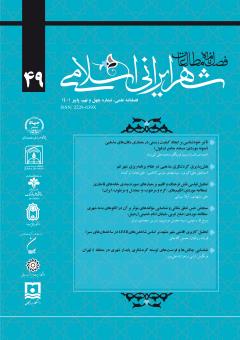نقش پذیری گردشگری مذهبی در نظام برنامهریزی شهر قم
محورهای موضوعی : شاخصهای شهر ایرانی اسلامی
اسماعیل علی اکبری
1
,
سیدمهدی موسی کاظمی
2
![]() ,
علی نجات ترکمان
3
,
علی نجات ترکمان
3
1 - استاد گروه جغرافیا، دانشگاه پیام نور، تهران، ایران
2 - دانشیار گروه جغرافیا، دانشگاه پیام نور، تهران، ایران
3 - دانشجوی دکتری جغرافیا و برنامهریزی شهری، دانشگاه پیام نور، تهران، ایران
کلید واژه: گردشگریمذهبی, برنامهریزیشهری, توسعه شهری, شهر قم,
چکیده مقاله :
گردشگری مذهبی نوعی از گردشگری است که شرکتکنندگان در آن به دلایل مذهبی انگیزه میگیرند. هدف پژوهش حاضر، بررسی نقش پذیری گردشگری مذهبی در نظام برنامهریزی شهر قم است. پژوهش حاضر از نظر هدف کاربردی توسعهای و از نظر روش توصیفی- تحلیلی بوده است. دادههای حاصل از پژوهش با روش اسنادی و میدانی مبتنی بر نظرات 35 نفر از خِبرگان و با استفاده از پرسشنامه محقق ساخت جمع آوری گردید. یافتههای پژوهش نشان داد؛ تا برنامه پنجم در هیچ سند یا برنامه بالادستی به طور مستقیم به گردشگری مذهبی اشارهای نشده است. اولویتبندی مؤلفهها نشان داد، حرم حضرت معصومه(س)، مسجد مقدس جمکران و اماکن مذهبی در توسعه کاربریهای شهر قم مهمترین مؤلفهها شناخته شده و برنامهریزان و مسئولین سطوح منطقهای و برنامهریزان سطح ملی و کلان پایینترین رتبه را از نظر کارشناسان در بین مؤلفهها داشتهاند. همچنین نتایج پژوهش نشان داد که توجه نظام برنامهریزی به گردشگری مذهبی در شهر قم و کل کشور متوسط به پائین و کم است. بنابراین، گردشگری مذهبی به عنوان یک واقعیت اجتماعی و فرهنگی نقش اساسی در توسعه پایدار گردشگری شهر قم و کشور دارد و مجریان، برنامهریزان و کنشگران با تهیه و اجرای برنامههای توسعه میتوانند موجبات توسعۀ گردشگری مذهبی را در ابعاد مختلف آن فراهم آورند.
Religious tourism is a type of tourism in which participants are motivated by religious reasons. The aim of the research is to investigate the role of religious tourism in the planning system of Qom city. This research has been developed in terms of practical purpose and in terms of descriptive-analytical method. The data obtained from the research was collected by documentary and field method based on the opinions of 35 experts and using a researcher-made questionnaire. The research findings showed; Religious tourism is not directly mentioned in any document or development plan until the fifth plan. The prioritization of the components showed that the shrine of Hazrat Masoumeh (PBUH), the Jamkaran Mosque and religious places are known as the most important components in the development of the landuses of Qom city, and the planners and officials of the regional levels and the national and local level planners have the lowest rank among the components according to the experts. Also, the results of the research showed that the planning system's attention to religious tourism in Qom city and the whole country is moderate to low. Concluding, as a social and cultural reality, religious tourism plays an essential role in the sustainable development of Qom and the country's tourism, and executives, planners and activists can provide reasons for the development of religious tourism in its various dimensions by preparing and implementing development plans.
